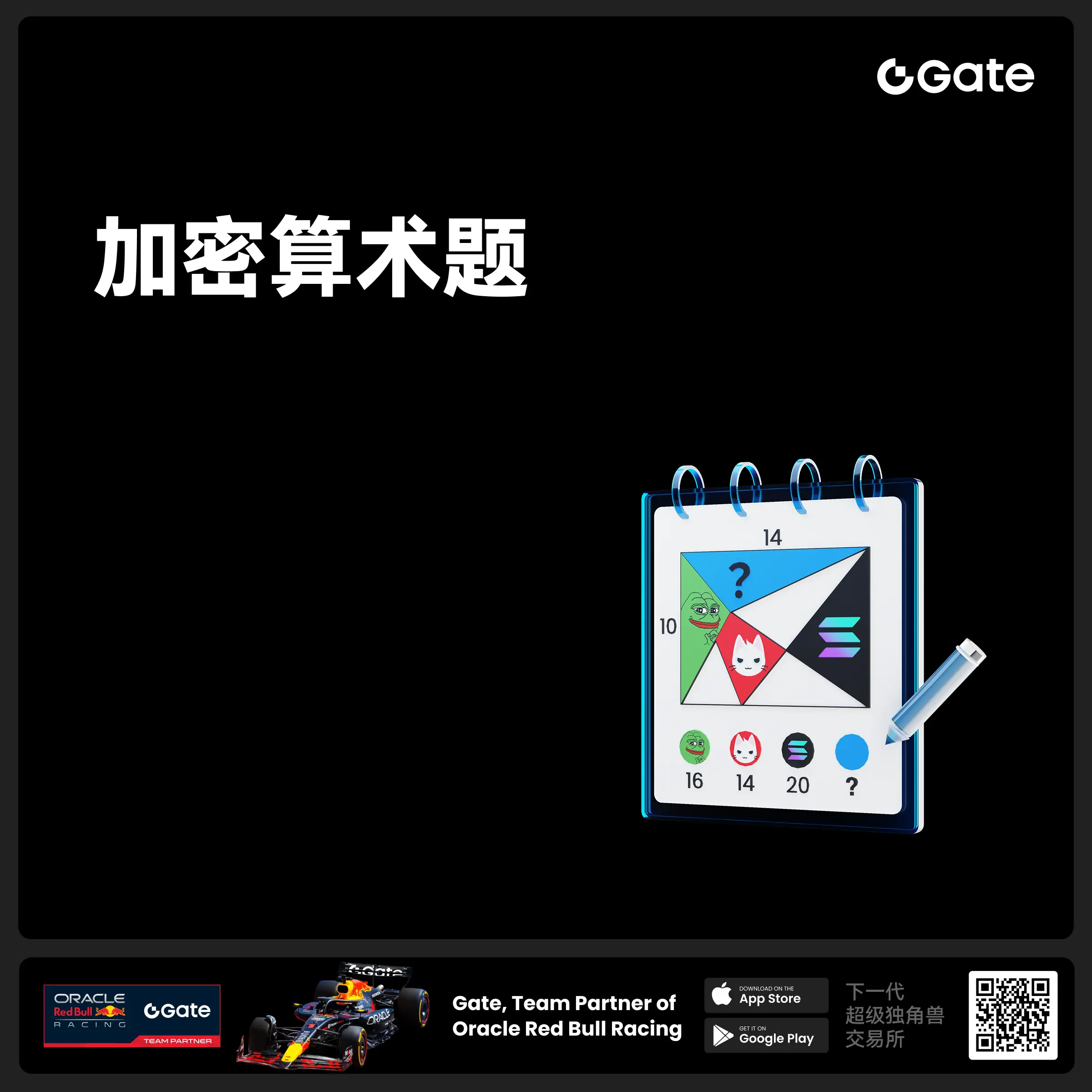更多
- 话题1/3
17k 热度
10k 热度
17k 热度
7k 热度
2k 热度
- 置顶
- 🎉Gate 2025 上半年社区盛典:内容达人评选投票火热进行中 🎉
🏆 谁将成为前十位 #Gate广场# 内容达人?
投票现已开启,选出你的心头好
🎁赢取 iPhone 16 Pro Max、限量周边等好礼!
📅投票截止:8 月 15 日 10:00(UTC+8)
立即投票: https://www.gate.com/activities/community-vote
活动详情: https://www.gate.com/announcements/article/45974
- 📢 #Gate广场征文活动第二期# 正式启动!
分享你对 $ERA 项目的独特观点,推广ERA上线活动, 700 $ERA 等你来赢!
💰 奖励:
一等奖(1名): 100枚 $ERA
二等奖(5名): 每人 60 枚 $ERA
三等奖(10名): 每人 30 枚 $ERA
👉 参与方式:
1.在 Gate广场发布你对 ERA 项目的独到见解贴文
2.在贴文中添加标签: #Gate广场征文活动第二期# ,贴文字数不低于300字
3.将你的文章或观点同步到X,加上标签:Gate Square 和 ERA
4.征文内容涵盖但不限于以下创作方向:
ERA 项目亮点:作为区块链基础设施公司,ERA 拥有哪些核心优势?
ERA 代币经济模型:如何保障代币的长期价值及生态可持续发展?
参与并推广 Gate x Caldera (ERA) 生态周活动。点击查看活动详情:https://www.gate.com/announcements/article/46169。
欢迎围绕上述主题,或从其他独特视角提出您的见解与建议。
⚠️ 活动要求:
原创内容,至少 300 字, 重复或抄袭内容将被淘汰。
不得使用 #Gate广场征文活动第二期# 和 #ERA# 以外的任何标签。
每篇文章必须获得 至少3个互动,否则无法获得奖励
鼓励图文并茂、深度分析,观点独到。
⏰ 活动时间:2025年7月20日 17
- 🧠 #GateGiveaway# - 加密算术题挑战!
你能解出这道加密题吗?
💰 $10 合约体验券 * 4 位获奖者
参与方式:
1️⃣ 关注 Gate广场_Official
2️⃣ 点赞此条动态贴文
3️⃣ 在评论中留下你的答案
📅 截止时间:7 月 22 日 12:00(UTC+8)
- 📢 ETH冲击4800?我有话说!快来“Gate广场”秀操作,0.1 ETH大奖等你拿!
牛市预言家,可能下一个就是你!想让你的观点成为广场热搜、赢下ETH大奖?现在就是机会!
💰️ 广场5位优质发帖用户+X浏览量前5发帖用户,瓜分0.1 ETH!
🎮 活动怎么玩,0门槛瓜分ETH!
1.话题不服来辩!
带 #ETH冲击4800# 和 #ETH# 在 广场 或 K线ETH下 围绕一下主题展开讨论:
-ETH是否有望突破4800?
-你看好ETH的原因是什么?
-你的ETH持仓策略是?
-ETH能否引领下一轮牛市?
2. X平台同步嗨
在X平台发帖讨论,记得带 #GateSquare# 和 #ETH冲击4800# 标签!
把你X返链接提交以下表单以瓜分大奖:https://www.gate.com/questionnaire/6896
✨发帖要求:
-内容须原创,字数不少于100字,且带活动指定标签
-配图、行情截图、分析看法加分,图文并茂更易精选
-禁止AI写手和灌水刷屏,一旦发现取消奖励资格
-观点鲜明、逻辑清晰,越有料越好!
关注ETH风向,创造观点价值,从广场发帖开始!下一个牛市“预言家”,可能就是你!🦾🏆
⏰ 活动时间:2025年7月18日 16:00 - 2025年7月28日 23:59(UTC+8)
【立即发帖】 展现你的真知灼见,赢取属于你的ETH大奖!
- 🎉 #Gate Alpha 第三届积分狂欢节 & ES Launchpool# 联合推广任务上线!
本次活动总奖池:1,250 枚 ES
任务目标:推广 Eclipse($ES)Launchpool 和 Alpha 第11期 $ES 专场
📄 详情参考:
Launchpool 公告:https://www.gate.com/zh/announcements/article/46134
Alpha 第11期公告:https://www.gate.com/zh/announcements/article/46137
🧩【任务内容】
请围绕 Launchpool 和 Alpha 第11期 活动进行内容创作,并晒出参与截图。
📸【参与方式】
1️⃣ 带上Tag #Gate Alpha 第三届积分狂欢节 & ES Launchpool# 发帖
2️⃣ 晒出以下任一截图:
Launchpool 质押截图(BTC / ETH / ES)
Alpha 交易页面截图(交易 ES)
3️⃣ 发布图文内容,可参考以下方向(≥60字):
简介 ES/Eclipse 项目亮点、代币机制等基本信息
分享你对 ES 项目的观点、前景判断、挖矿体验等
分析 Launchpool 挖矿 或 Alpha 积分玩法的策略和收益对比
🎁【奖励说明】
评选内容质量最优的 10 位 Launchpool/Gate
Everyone laughed at these 10 gadgets. Now, they’re in every home
Before they were in every home, some of the most essential gadgets of today were technological punchlines, too weird, too early, too expensive or just plain bad
In the ’90s and early 2000s, inventors and engineers dreamed big, but consumer tech often struggled to deliver on its promise
Whether it was a robotic pet that couldn’t love you back, a vacuum that kept slamming into furniture or a digital currency no one could figure out how to use, many of these innovations failed hard.
But failure wasn’t the end. In most cases, these flops planted the seeds for the tools we now take for granted
This list revisits the early prototypes that got laughed out of stores, and shows how their core ideas came roaring back, better, cheaper and smarter.
1. Smart vacuum (Electrolux Trilobite → robot vacuum)
The Electrolux Trilobite (2001) was the world’s first consumer robotic vacuum cleaner. It featured ultrasonic sensors and automatic docking — radical for its time — but fell short on usability. It missed corners, struggled with door thresholds and frequently got stuck. It was out of reach for most at 1,600 euros (about $1,850 today).
Now:
Robot vacuums are now affordable and impressively smart. iRobot’s Roomba j7+ uses AI and a front-facing camera to avoid pet messes and cables
Even the budget Eufy RoboVac G30 delivers solid performance and room mapping for under $300.
2. Wearable companion device (Sega Dreamcast VMU → smartwatch)
The Visual Memory Unit (1998) was Sega’s quirky add-on for the Dreamcast: a memory card with a tiny screen that could show in-game stats or play minigames. It was fun but limited, battery-hungry, low on memory and largely ignored by developers.
Now:
Smartwatches like Apple Watch Series 9 and Google Pixel Watch 2 offer a rich second-screen experience fully integrated with your phone
3. Digital assistant robot (Sony AIBO → home robot/pet robot)
Sony’s original AIBO (1999) was a robotic dog with basic sensors and movement capabilities. It responded to voice commands and displayed simulated emotions. But its $2,500 price tag, repetitive behaviors and lack of real-world function made it more of a novelty than a companion.
Now:
Modern home robots have split into functional and emotional lanes. Amazon Astro and ElliQ assist with daily tasks and elder care, while reimagined pet bots like AIBO (relaunched in 2018), Loona and Moflin now recognize faces, respond with nuanced behavior and learn from interaction.
The Virtual Boy (1995) was Nintendo’s early stab at 3D gaming, using red-on-black stereoscopic displays. Unfortunately, it had poor ergonomics, a limited library of just 22 games and caused eye strain and headaches. It was discontinued within a year.
Now:
VR headsets like the Meta Quest 3 and PS VR2 offer full-color OLED displays, spatial tracking and immersive content libraries. They’re lighter, wireless and usable for work, gaming and fitness — delivering on Virtual Boy’s vision in every way.
The AT&T EO Personal Communicator (1993) was among the first devices to combine a phone, fax, modem, email and PDA functions. But it weighed over two pounds, cost up to $3,000 and had poor battery life. It launched too early, and only about 10,000 units were sold.
Now:
Today’s smartphones — like the iPhone 16 Pro and Samsung Galaxy S25 — compress all those functions and more into sleek, powerful devices. With apps, high-res cameras, AI chips and blazing-fast internet, they make the EO look like a stone tablet.
Sharp’s Zaurus line, like the SL-C3000 (2005), was a rare breed: pocket-sized Linux-based PCs with full keyboards, stylus input and developer flexibility. It was beloved by tech tinkerers but failed to reach the mainstream due to high prices (~$500–$700), limited connectivity and buggy software.
Now:
The Zaurus legacy lives on in the Raspberry Pi ecosystem. The Raspberry Pi 5 and DIY NAS setups using Unraid or TrueNAS offer massive flexibility for media streaming, automation, or even home servers, all for under $100 and supported by vibrant online communities.
Apple’s Newton MessagePad (1993) was a pioneer: a handheld device with stylus input and handwriting recognition. But it couldn’t reliably recognize text, its most-hyped feature. It was bulky, slow and expensive (~$700), and quickly became the butt of jokes for misreading even simple phrases like “catching on” as “egg freckles.”
Now:
Today’s tablets, like the iPad Pro, Samsung Galaxy Tab and Microsoft Surface combine precise stylus input with pressure sensitivity, fast processors and cloud sync
Handwriting apps like Notability and OneNote make note-taking seamless. What Newton aimed to do in the ‘90s is now effortlessly handled by sleek, powerful devices.
Sega’s VMU (1999) included small “Chao” minigames to play on the go, offering early portable interaction tied to a console. But they were shallow, battery-draining and not very replayable.
Why it failed:
Portable gaming now rivals full-fledged consoles. Nintendo Switch and Valve Steam Deck play AAA games anywhere, with vibrant screens and real controllers. Add cloud gaming options like GeForce Now or ROG Ally, and mobile gaming has become an entire ecosystem.
Finland’s Avant stored-value smartcard (1993) and David Chaum’s DigiCash (1990) offered early visions of digital currency. Avant worked like a prepaid debit card, while DigiCash allowed anonymous transfers. Both failed due to low demand, poor infrastructure and regulatory roadblocks.
Now:
As of 2025, 134 countries (representing 98% of global GDP) are developing or piloting central bank digital currencies (CBDCs). Examples include:
CBDCs are now used for welfare disbursements, transportation payments and remittances, marking a significant evolution in state-backed digital money.
In the mid-2000s, Dutch inventor Fred van der Weij built an enormous, homemade device to solve a personal problem: how to make crispy fries without oil. His early air fryer prototype, made from wood, metal and aluminum mesh, looked more like a backyard science project than a kitchen appliance. It worked (barely) but was never intended for mass production.
Now:
Today’s air fryers are sleek, countertop must-haves. Models like the Ninja Foodi DualZone or Cosori Pro can roast, bake, reheat and dehydrate, often replacing entire ovens
They use refined convection technology, require minimal oil and come with presets, app integration and dishwasher-safe baskets. What began as a giant wooden box is now one of the most popular kitchen tools in the world.
Tech history is full of false starts. Yet even the most awkward, overhyped gadgets often contain a sliver of the future. What flopped in 1995 might be indispensable in 2025. Robotic assistants, virtual reality, CBDCs and wearable tech — each was mocked in its early form, but their underlying concepts proved resilient.
It’s a reminder that innovation doesn’t always arrive fully formed. Sometimes it shows up wearing red-tinted goggles, costs too much and breaks after three days. But give it a few years and a few billion dollars of R&D and you just might find it in your pocket, running your home or helping you pay for coffee.
This article does not contain investment advice or recommendations. Every investment and trading move involves risk, and readers should conduct their own research when making a decision.